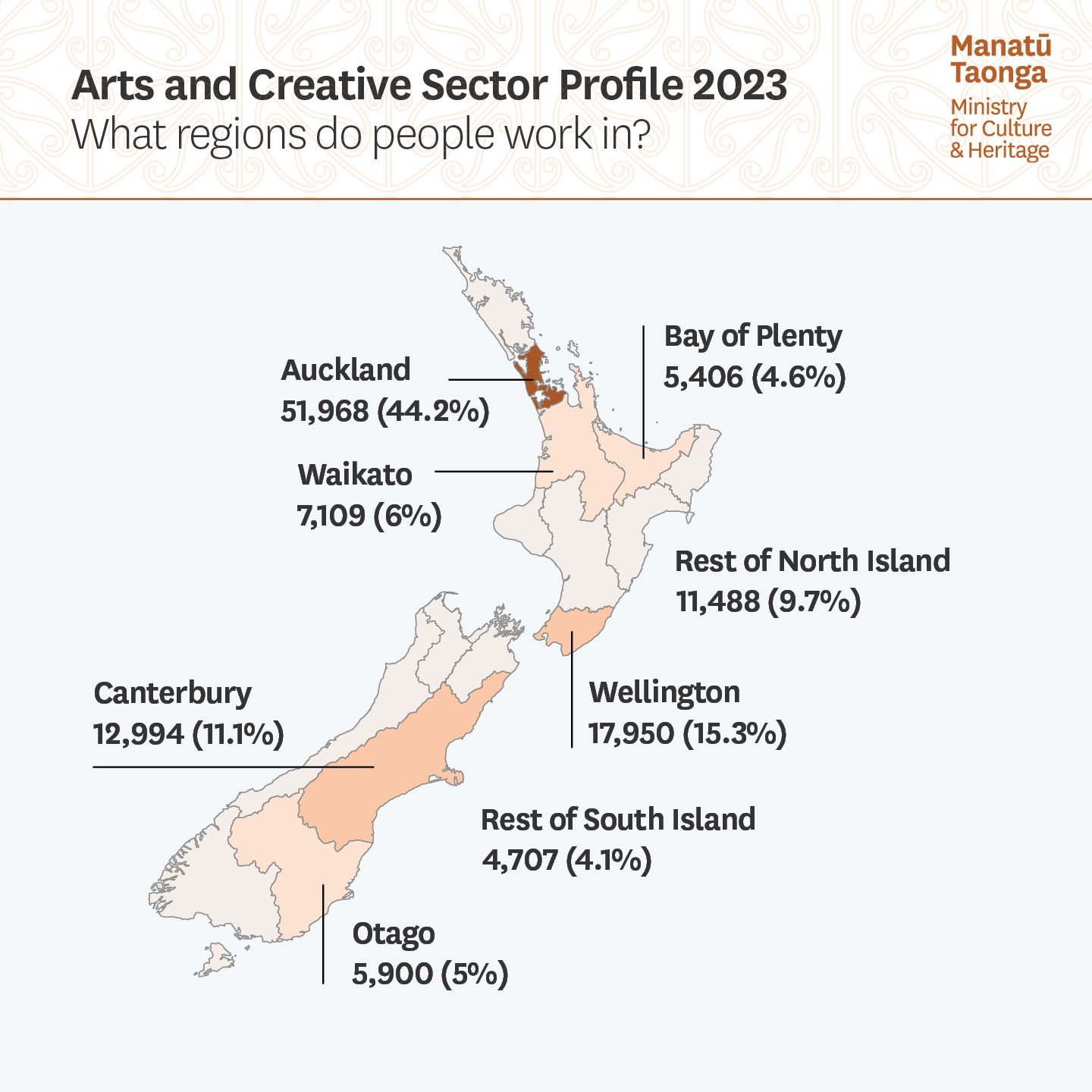EXCLUSIVE: NZ Creative Sector Now Worth $16.3 Billion
Arts and creativity sector received a $1.4b boost - as the latest MCH figures are released. We break down some of the key statistics.

Did you feel it?
That extra 10-figure financial injection into Aotearoa's creative sector?
It's a number to make your eyes water - some with tears of frustration.
It may be proving tough for many in the creative community to make a living in this financial climate, but the numbers categorically point to the fact that there has never been a higher recorded contribution to the arts and creative sector.
Manatū Taonga Ministry for Culture and Heritage (MCH) have been monitoring the economic characteristics of the sector from data supplied by Infometrics. As the new report shows, in the year to March 2023, the arts and creative sector brought in $16.3 billion - up from the $14.9b when the last report was made public in November last year (see the breakdown of that previous report here).
That translates to the sector providing 4.3% of Aotearoa's total GDP - a number that is a new benchmark of the stats that go back to 2000.
While the registered growth feels like it cuts against the lived experiences of many in the sector, MCH Deputy Secretary Policy and Sector Performance, Emily Fabling explained the process to The Big Idea.
"The main areas we look at when considering growth are GDP contribution and employment. For example, if you look at GDP contribution, the overall trend in growth for the arts and creative sector over the past five years is an increase of just over 5% per year on average.
"The pandemic created a lot of instability for the sector, both in Aotearoa and globally, which is reflected in the data over the past few years. It’s encouraging to see based on this data, however, that the sector appears to be recovering."
There's no hiding away from the fact the headline number is impressive - and one Fabling points to as the standout feature
"We’re really interested in value and impact. The data highlights the strong economic value of the arts and creative sector — contributing $16.3 billion to New Zealand’s GDP in the year to March 2023.
"The economic data is one measure that shows us that while times are tough, the sector is resilient and continuing to make a significant contribution to New Zealand’s economy."
Looking at some of the other key metrics announced:
- The cultural sector’s GDP contribution grew by 5.3% over the past year, compared to 2.9% growth for the rest of the economy.
- For some parts of the sector, GDP growth was even higher – 6.5% for the Māori Arts and Creative sub-sector, and 9.2% for the Arts sub-sector.
- Productivity in the Arts and Creative sector grew by 1.7% to $155,539. Over the past five years (2018-2023), productivity has grown by 3% per annum on average, where the total economy has remained relatively flat (0.2%)
- More than 117,000 people held primary employment in the arts and creative sector in the year to March 2023. Within this workforce, just over 11,000 identify as Māori
- There are 37,157 businesses in the arts and creative sector
- 31 % of people with primary jobs in the sector are self- employed, compared to 15.9% of the total economy

While growth year on year is up, it's less than the previous year – 5.3% in this report compared to 11.1% in 2022. The Big Idea asked Fabling if is the lower percentage growth in the sector an issue.
"Slightly less growth compared to last year isn’t a cause for concern, but the Ministry will continue to monitor performance of the wider cultural system to inform our advice to Government.
"If you look at the year prior (the year to March 2021), you’ll see there was a sharp decline in growth due to COVID-19, especially in the Arts sub-sector. This means that by comparison last year’s figures may seem higher as they were rebounding from that decline.
"It’s important to consider these growth figures within a longer-term context, as the sector is still recovering in many ways."
When asked what areas the sector should be concerned about from the report, Fabling replied "While the figures appear encouraging this year overall, we know some areas of our cultural system are more vulnerable to the ongoing challenges experienced across our economy — we’re seeing that right now with employment in the media and production sectors, for example.
"Costs are also rising in many areas of the system – from insurance costs for physical spaces and assets, to freight and travel costs for touring events.
"There are also some employment characteristics that may have implications when considering career sustainability. For example, we know self-employment is high in the arts and creative sector — around twice that of the general economy."
Art's solo spotlight
Last year, MCH worked with Creative New Zealand (CNZ) to define and create a new arts sector profile to gain a more accurate understanding of the challenges those in the arts specifically face.
Here are some of the key stats (and here's the full report), with comparison available for the first time.
- The arts has a GDP of $3.107m GDP - which 0.8% of New Zealand GDP, the same percentage as the previous report but up almost $400,000
- There are 28,268 filled arts jobs, up from 27,717 but remaining at 1% of NZ's overall filled jobs like the last information release
- The stats report 11,199 businesses in Arts Sector, up from 10,754
- 11,262 arts workers are self-employed - at 39.8%, it's more than twice the self-employment rate of NZ as a whole (15.9%)
- 55.5% of art sector workers are female - comfortably above the total of female workers in total in Aoteroa (47.8%)
Of those working in the sector, the top five occupations are unchanged in order from last year's information:
Music Teacher (Private Tuition)
Painter (Visual Arts)
Author
Dance Teacher (Private Tuition)
Musician (Instrumental)
The report's projections suggest there will be 12,507 Total job openings in the arts between now and 2029 - (New jobs: 4,910, Net Replacement job openings: 7,596).
NZ loves the arts - report

That's not the only piece of information MCH has dropped in a busy 24-hour period.
They've just published their Cultural Participation Survey - the 67-page report has plenty to digest, but there are certainly some stats that will give those who sing from the rooftops of the true intrinsic value of the arts plenty of new fodder.
Among some of the eye-catching numbers:
- almost three in four New Zealanders (71%) reported watching a New Zealand-made programme, series or documentary (excluding news and sports) at least occasionally, with 44% watching weekly
- 51% of New Zealanders reported going to the library in the last three months
- 35% of New Zealanders reported visiting a visual arts gallery in the last 12 months.
- 29% of New Zealanders reported going to a museum in the last three months
- one in five New Zealanders (21%) reported attending a musical, dance or theatre performance in the last three months
- listening to commercial radio is the most frequently engaged in activity, with 66% listening at least once a week in 2023